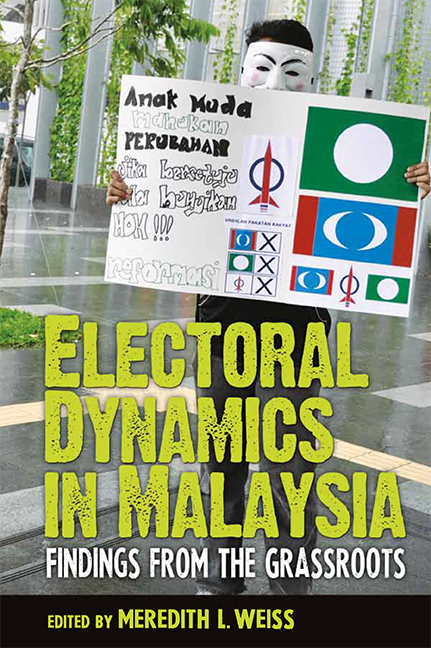Book contents
- Frontmatter
- Contents
- List of Tables
- Foreword
- Acknowledgements
- Glossary & Acronyms
- Chapter 1 Introduction: Patterns and Puzzles in Malaysian Electoral Dynamics
- Chapter 2 Arau, Perlis: The Irresistible Charm of Warlords, Women and Rewards?
- Chapter 3 Padang Serai, Kedah: Between the ‘Personal Touch’ and the Generous Hand
- Chapter 4 Kuala Nerus, Terengganu: New Malay Politics?
- Chapter 5 Balik Pulau, Penang: Home Run for the Home Boys
- Chapter 6 Lumut, Perak: Patronage, Clientelism and the Post-Coup Order
- Chapter 7 Kuantan, Pahang: Revealing the Ordinary
- Chapter 8 Pandan, Selangor: New Electoral Dynamics in Urban Malaysia
- Chapter 9 Kepong and Titiwangsa, Kuala Lumpur: Messages or Money?
- Chapter 10 Rembau, Negeri Sembilan: Personalities and Promises
- Chapter 11 Pulai, Johor: A Tale of Two Coalitions
- Chapter 12 Gelang Patah, Johor: Did Lim Kit Siang Truly Win His Last Gamble?
- Chapter 13 Kota Marudu and Keningau, Sabah: Personality, Patronage and Parochial Politics
- Chapter 14 Tuaran, Sabah: Party Loyalty and Rational Voting
- Chapter 15 Kota Kinabalu, Sabah: BN Loses Its ‘Fixed Deposit’
- Chapter 16 Beaufort, Sabah: Whither Lajim's Popularity?
- Chapter 17 Sibu and Lanang, Sarawak: Defeat of the Bosses
- Contributors
Chapter 8 - Pandan, Selangor: New Electoral Dynamics in Urban Malaysia
Published online by Cambridge University Press: 10 November 2017
- Frontmatter
- Contents
- List of Tables
- Foreword
- Acknowledgements
- Glossary & Acronyms
- Chapter 1 Introduction: Patterns and Puzzles in Malaysian Electoral Dynamics
- Chapter 2 Arau, Perlis: The Irresistible Charm of Warlords, Women and Rewards?
- Chapter 3 Padang Serai, Kedah: Between the ‘Personal Touch’ and the Generous Hand
- Chapter 4 Kuala Nerus, Terengganu: New Malay Politics?
- Chapter 5 Balik Pulau, Penang: Home Run for the Home Boys
- Chapter 6 Lumut, Perak: Patronage, Clientelism and the Post-Coup Order
- Chapter 7 Kuantan, Pahang: Revealing the Ordinary
- Chapter 8 Pandan, Selangor: New Electoral Dynamics in Urban Malaysia
- Chapter 9 Kepong and Titiwangsa, Kuala Lumpur: Messages or Money?
- Chapter 10 Rembau, Negeri Sembilan: Personalities and Promises
- Chapter 11 Pulai, Johor: A Tale of Two Coalitions
- Chapter 12 Gelang Patah, Johor: Did Lim Kit Siang Truly Win His Last Gamble?
- Chapter 13 Kota Marudu and Keningau, Sabah: Personality, Patronage and Parochial Politics
- Chapter 14 Tuaran, Sabah: Party Loyalty and Rational Voting
- Chapter 15 Kota Kinabalu, Sabah: BN Loses Its ‘Fixed Deposit’
- Chapter 16 Beaufort, Sabah: Whither Lajim's Popularity?
- Chapter 17 Sibu and Lanang, Sarawak: Defeat of the Bosses
- Contributors
Summary
Introduction
Pandan is a parliamentary constituency in the state of Selangor which comprises two state seats, Chempaka and Teratai, Malay-majority and Chinese-majority areas respectively; therefore Pandan is considered a mixed seat. During the 13th general election (GE13), all three seats were contested by the two main coalitions in Malaysia, Barisan Nasional (BN) and Pakatan Rakyat (Pakatan).
Pandan saw Mohd Rafizi bin Ramli from Parti Keadilan Rakyat (PKR) pitted against Gary Lim Chin Yee from the Malaysian Chinese Association (MCA), with Allan Tan Yew Leng contesting as an independent candidate. There was a straight fight in Chempaka between Iskandar bin Abdul Samad from Parti Islam SeMalaysia (PAS) and Muhammad Faizal bin Sufar from the United Malays National Organisation (UMNO). Teratai was contested by Tiew Way Keng from the Democratic Action Party (DAP), Ben Liew Pok Boon from Parti Gerakan Rakyat Malaysia (Gerakan) and three independents – Jenice Lee Ying Ha, Chin Kok Keong and Lim Ah Chai. PKR, PAS and DAP make up Pakatan, while MCA, UMNO and Gerakan are from BN.
The electoral campaigns in Pandan suggest a new dynamic emerging, in which candidates and voters alike favour policy-based campaigns as opposed to campaigns run on racial or patronage platforms. The next section describes how party structure, candidate selection and campaign machinery influenced the mobilisation of voters, as well as how campaigns were financed. The following section then explores trends which indicate the democratisation of electoral dynamics in Pandan. A closer examination, however, reveals that campaign funding remains highly confidential for both Pakatan and BN.
Progress of the campaign
The Pandan parliamentary constituency straddles the boundary of Kuala Lumpur (a federal territory) and the state of Selangor. Despite its proximity to the Kuala Lumpur city centre, Pandan has a large population of urban poor, although the majority of its residents are from the middle-income working class (Chooi 2013c). Development here mainly consists of sprawling residential terrace housing, apartments and fairly large areas of commercial shoplots. Chempaka has relatively more low-cost flats than Teratai, as well as pockets of semi-rural Malay villages or squatters. Overall, Pandan is considered an urban and semi-urban seat.
- Type
- Chapter
- Information
- Electoral Dynamics in MalaysiaFindings from the Grassroots, pp. 107 - 124Publisher: ISEAS–Yusof Ishak InstitutePrint publication year: 2013

